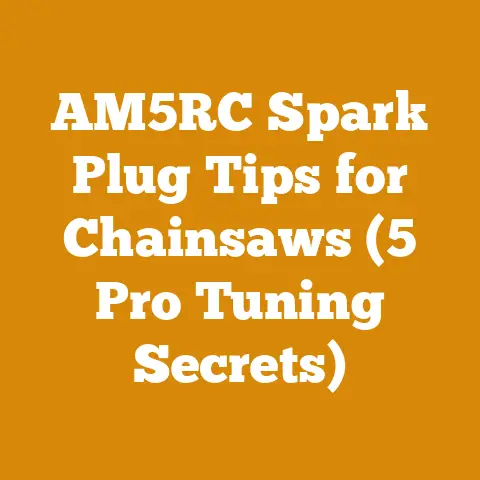Husqvarna Bar & Chain Fit Chart (5 Expert Tips for Perfect Match)
Remember the satisfying scent of freshly cut wood, the rhythmic roar of a chainsaw biting into a stubborn log? The crisp air of autumn, the promise of a warm fire crackling on a cold winter night? Those memories are often intertwined with the tools that make it all possible, and at the heart of it all is the humble chainsaw bar and chain. But getting the right fit? That’s where the rubber meets the road, or rather, where the chain meets the wood.
Husqvarna Bar & Chain Fit Chart: 5 Expert Tips for a Perfect Match
Choosing the right bar and chain for your Husqvarna chainsaw isn’t just about slapping on whatever looks good. It’s about optimizing performance, extending the life of your saw, and most importantly, staying safe. A mismatched bar and chain can lead to kickback, premature wear, and a whole host of other problems. Today, I’m going to guide you through the often-confusing world of Husqvarna bar and chain selection, sharing five expert tips to ensure you get the perfect match. And because I’m me, we’ll also delve into the costs associated with keeping your saw humming, because knowing what things really cost is half the battle.
1. Understanding the Basics: Pitch, Gauge, and Drive Links
Before we dive into the fit chart, let’s cover the fundamentals. These three measurements are crucial for compatibility.
- Pitch: This is the distance between any three consecutive rivets on the chain, divided by two. Common pitches are .325″, 3/8″ (0.375″), and .404″. Think of it as the chain’s “stride.” A longer stride (larger pitch) is generally used for larger saws and harder wood.
- Gauge: This is the thickness of the drive links where they fit into the bar groove. Common gauges are .043″, .050″, .058″, and .063″. The gauge of your chain must match the gauge of your bar.
- Drive Links: These are the small links that fit into the groove of the guide bar and pull the chain around. The number of drive links determines the length of the chain needed for a specific bar.
Why are these important? Imagine trying to fit a square peg in a round hole. A chain with the wrong pitch won’t engage properly with the sprocket. A chain with the wrong gauge won’t fit snugly in the bar groove, leading to excessive wear and potential derailment. And if you don’t have the correct number of drive links, your chain will be either too loose or too tight.
My Experience: I once tried to be clever and used a chain with a slightly different gauge on an old Husqvarna. It ran, but it was a vibrating, chattering nightmare. The chain kept jumping, the bar got incredibly hot, and I ended up damaging both the bar and the chain. A costly lesson learned the hard way.
2. Consulting the Husqvarna Bar & Chain Fit Chart (and Knowing Where to Find It)
Husqvarna provides detailed bar and chain fit charts, usually available on their website or at authorized dealerships. These charts are invaluable resources, but they can sometimes be a bit overwhelming. Here’s how to navigate them effectively:
- Identify Your Chainsaw Model: The chart will typically be organized by chainsaw model. Make sure you know the exact model number of your Husqvarna saw.
- Find the Recommended Bar Length: The chart will list the recommended bar lengths for your model. You’ll often find a range of acceptable lengths.
- Note the Pitch, Gauge, and Drive Link Count: The chart will specify the correct pitch, gauge, and number of drive links for each bar length.
- Cross-Reference with Chain Availability: While the chart recommends certain specs, you’ll need to ensure those specs are available in the chain brands you prefer.
Where to Find the Chart:
- Husqvarna Website: The official Husqvarna website is the best place to start. Look for a “Bar and Chain Selector” or “Parts Lookup” tool.
- Husqvarna Dealerships: Authorized dealerships can provide printed charts and expert advice.
- Online Retailers: Many online retailers selling Husqvarna chainsaws and accessories also provide fit charts.
Example: Let’s say you have a Husqvarna 455 Rancher. The fit chart might recommend bar lengths of 16″, 18″, or 20″. For an 18″ bar, it might specify a pitch of .325″, a gauge of .050″, and 72 drive links.
Important Note: Always double-check the information on the chart with your chainsaw’s owner’s manual. The manual is the ultimate authority on the correct bar and chain specifications.
3. Considering Your Cutting Needs and Wood Type
The fit chart is a great starting point, but it doesn’t take into account your specific cutting needs. Are you primarily felling large trees, limbing branches, or cutting firewood? The type of wood you’re cutting also plays a significant role.
- Bar Length: A longer bar allows you to cut larger diameter trees in a single pass. However, it also adds weight and can be more difficult to maneuver. For general firewood cutting and limbing, a shorter bar (16″-18″) is often preferable. For felling larger trees, you might want to consider a longer bar (20″+).
- Pitch: A larger pitch (e.g., .404″) is generally better for harder woods and larger saws. A smaller pitch (e.g., .325″) is suitable for softer woods and smaller saws.
-
Chain Type: Different chain types are designed for different purposes.
- Full Chisel: These chains have aggressive cutters that slice through wood quickly. They are best suited for clean wood and experienced users.
- Semi-Chisel: These chains have rounded cutters that are more forgiving and less prone to dulling in dirty or frozen wood. They are a good all-around choice.
- Low-Kickback: These chains are designed to reduce the risk of kickback, making them a safer option for beginners.
My Story: I once tackled a massive oak tree with a chainsaw equipped with a bar that was too short. It was a grueling experience that took far longer than it should have. I also quickly learned that cutting oak with a dull chain is an exercise in frustration. Choosing the right bar length and chain type can make a world of difference.
Cost Implications: Using the wrong bar and chain for the job can lead to increased wear and tear on your saw, requiring more frequent maintenance and replacement parts. It can also increase your cutting time, which translates to higher fuel consumption and more labor costs (if you’re paying someone to do the work).
4. Understanding the Costs: A Deep Dive into Chainsaw Bar and Chain Economics
Now, let’s talk about money. Owning a chainsaw isn’t just about the initial purchase price. It’s about the ongoing costs of maintenance, fuel, and replacement parts, including bars and chains. Let’s break down the cost factors:
-
Bar Costs:
- Entry-Level Bars: These can range from $30 to $60, suitable for occasional users and smaller saws.
- Mid-Range Bars: Expect to pay $60 to $120 for a good quality bar that will last longer and perform better.
- Professional-Grade Bars: These can cost $120 to $250 or more, designed for heavy use and demanding conditions.
- Factors Affecting Bar Cost: Bar length, brand, construction materials (e.g., laminated vs. solid steel), and features (e.g., replaceable sprocket nose) all influence the price.
-
Chain Costs:
- Entry-Level Chains: These can be as low as $15 to $30, but they may not hold an edge for long.
- Mid-Range Chains: Expect to pay $30 to $50 for a chain that offers a good balance of performance and durability.
- Professional-Grade Chains: These can cost $50 to $80 or more, designed for fast cutting and long life.
- Factors Affecting Chain Cost: Chain type (full chisel, semi-chisel, low-kickback), pitch, gauge, and brand all affect the price.
-
Hidden Costs:
- Sharpening: Chains need to be sharpened regularly to maintain optimal performance. You can sharpen them yourself (requiring a sharpening kit) or pay a professional. Professional sharpening typically costs $10-$20 per chain.
- Bar Maintenance: Bars need to be cleaned, lubricated, and occasionally dressed (to remove burrs and restore the groove). Neglecting bar maintenance can shorten its lifespan.
- Downtime: A dull chain or a damaged bar can slow down your cutting progress and lead to downtime. This can be especially costly if you’re running a commercial operation.
Data and Benchmarks:
- According to a survey of professional loggers, the average lifespan of a chainsaw bar is 6 months to 2 years, depending on usage and maintenance.
- The average cost of replacing a chainsaw chain is $40 (mid-range chain).
- The average cost of professional chainsaw sharpening is $15 per chain.
Cost Optimization Tips:
- Buy Quality: Investing in a good quality bar and chain will pay off in the long run through increased durability and performance.
- Maintain Your Equipment: Regular cleaning, lubrication, and sharpening will extend the life of your bar and chain.
- Sharpen Your Own Chains: Learning to sharpen your own chains can save you money and ensure that you always have a sharp chain on hand.
- Rotate Your Chains: Having multiple chains allows you to rotate them, giving each chain a chance to cool down and reducing wear.
- Consider Refurbishing: Some chainsaw shops offer bar refurbishment services, which can save you money on replacement costs.
My Budgeting Example: For my own firewood operation, I budget approximately $150 per year for bar and chain maintenance for each of my two chainsaws. This includes the cost of new chains, sharpening supplies, and occasional bar repairs. I also factor in the cost of downtime in case of equipment failure.
5. Expert Tips for Choosing the Right Bar and Chain
Beyond the basics, here are some expert tips to help you make the best choice:
- Consult with a Professional: If you’re unsure about which bar and chain to choose, talk to a knowledgeable salesperson at a Husqvarna dealership. They can assess your needs and recommend the best options.
-
Consider the Bar Nose Type: Different bar nose types offer different advantages.
- Sprocket Nose: These bars have a sprocket at the tip that reduces friction and improves cutting speed. They are a good choice for felling and bucking.
- Hard Nose: These bars have a solid, hardened tip that is more durable and less prone to damage. They are a good choice for limbing and cutting dirty wood.
-
Pay Attention to Bar and Chain Lubrication: Proper lubrication is essential for extending the life of your bar and chain. Use a high-quality bar and chain oil and check the oil level frequently.
- Break In New Chains Properly: New chains need to be broken in properly to ensure optimal performance. Run the chain at low speed for a few minutes before putting it to work.
- Don’t Over-Tighten the Chain: A chain that is too tight will generate excessive heat and wear. The chain should be able to be pulled away from the bar slightly.
My Pro Tip: I always keep a spare bar and chain on hand. This allows me to quickly swap out a damaged or dull chain and keep working. It’s a small investment that can save you a lot of time and frustration.
Actionable Takeaways and Next Steps:
- Identify your Husqvarna chainsaw model.
- Consult the Husqvarna bar and chain fit chart.
- Consider your cutting needs and wood type.
- Understand the costs associated with bar and chain maintenance.
- Follow the expert tips for choosing the right bar and chain.
- Talk to a professional if you have any questions.
Choosing the right bar and chain for your Husqvarna chainsaw is an important decision that can affect performance, safety, and cost. By following these expert tips, you can ensure that you get the perfect match for your needs. Now, get out there and make some sawdust!






